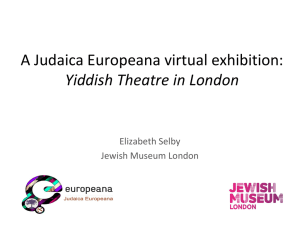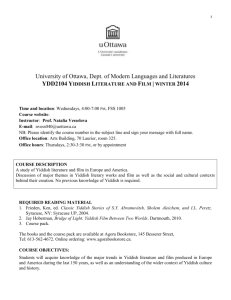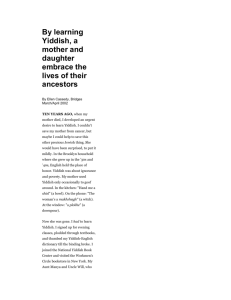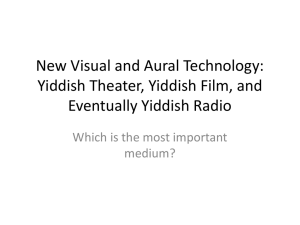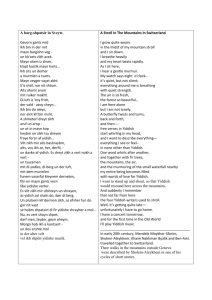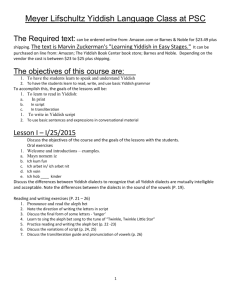Students` responsibilities
advertisement
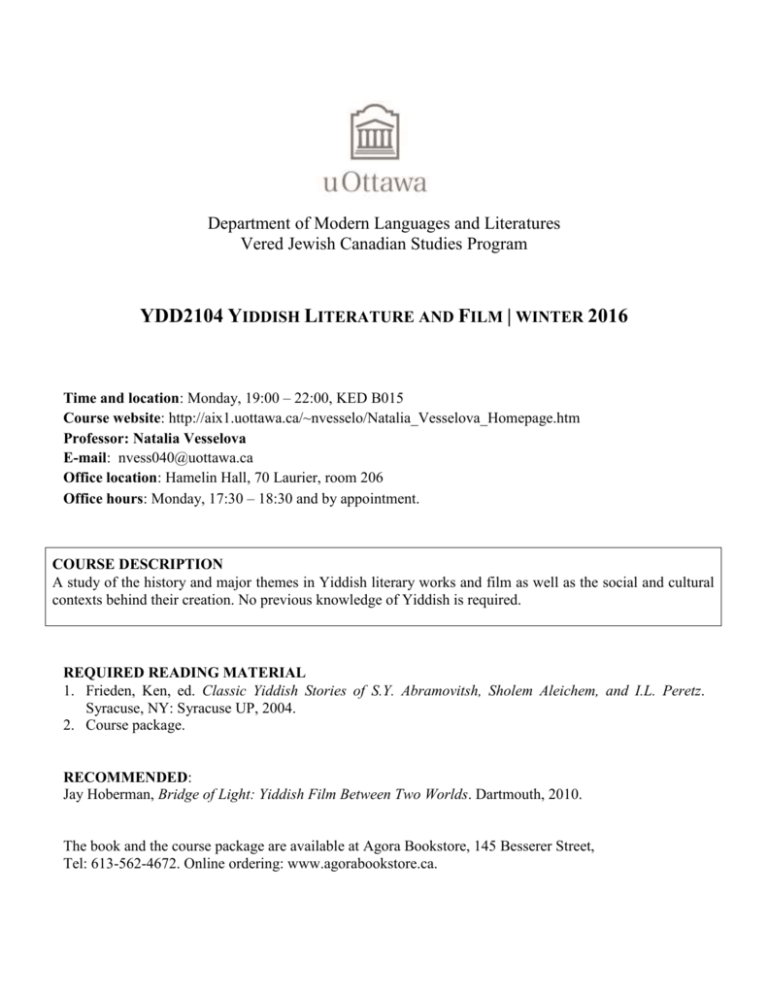
Department of Modern Languages and Literatures
Vered Jewish Canadian Studies Program
YDD2104 YIDDISH LITERATURE AND FILM | WINTER 2016
Time and location: Monday, 19:00 – 22:00, KED B015
Course website: http://aix1.uottawa.ca/~nvesselo/Natalia_Vesselova_Homepage.htm
Professor: Natalia Vesselova
E-mail: nvess040@uottawa.ca
Office location: Hamelin Hall, 70 Laurier, room 206
Office hours: Monday, 17:30 – 18:30 and by appointment.
COURSE DESCRIPTION
A study of the history and major themes in Yiddish literary works and film as well as the social and cultural
contexts behind their creation. No previous knowledge of Yiddish is required.
REQUIRED READING MATERIAL
1. Frieden, Ken, ed. Classic Yiddish Stories of S.Y. Abramovitsh, Sholem Aleichem, and I.L. Peretz.
Syracuse, NY: Syracuse UP, 2004.
2. Course package.
RECOMMENDED:
Jay Hoberman, Bridge of Light: Yiddish Film Between Two Worlds. Dartmouth, 2010.
The book and the course package are available at Agora Bookstore, 145 Besserer Street,
Tel: 613-562-4672. Online ordering: www.agorabookstore.ca.
2
COURSE OBJECTIVES:
Students will acquire knowledge of the major trends in Yiddish literature and film produced in Europe
and America during the last 150 years, as well as an understanding of the wider context of Yiddish culture
and history.
EVALUATION
ITEM
VALUE
DATE
1
Attendance and participation
5%
Cumulative
2
Presentation
10%
TBA
Written assignment 1
15%
4
Midterm exam
20%
February 29
5
Written assignment 2
20%
April 4
6
Final exam (take-home)
30%
TBA
3
February 8
ASSIGNMENTS
Attendance and Participation
Attendance at all lectures and viewing of all of the films is mandatory. Students are expected to read the
required materials before each class. Active participation in class discussions or/and afterthoughts sent to
the professor by e-mail will be evaluated as well.
Presentation
A brief, approx. 3 min. talk on a chosen topic pertaining to the course subject matter. The presentations
will be followed by a class discussion of the issues raised.
Written Assignment 1
Explore any aspect of the culture clash between traditional Yiddish values/way of living and the “New
World” as reflected in fiction or/and film. Use non-fiction materials for reference and background
information.
Required length: approximately 1,200 words, including the list of works cited.
Written Assignment 2
Come up with a clear thesis linking one of the discussed films and fiction. Use non-fiction reading
materials for reference and background information.
All students should verify their topic with the professor in advance.
Required length: approximately 2,000 words, including the list of works cited.
3
For quotations and references, in-text citation must be used (author’s last name, page), with the full list of
works cited at the end of the essay. Written assignments should be typed in double-spaced Times New
Roman 12-point font, 1” margins, and stapled.
The essay evaluation will be based on:
clarity of the thesis;
originality of ideas;
precision and detail of analysis;
logic and structure of argumentation;
level of style, spelling, and punctuation;
accuracy of referencing.
For various writing problems, free help is available from the University Academic Writing Centre
(www.sass.uottawa.ca/writing/centre.php).
Midterm
Format: short identification questions (40 points), essay questions (60 points).
Students who require accommodation during examinations must register with Access Services:
www.sass.uottawa.ca/access.
Final exam
The final exam will be in a take-home format. The questions will be provided during the last week of the
semester.
STUDENTS’ RESPONSIBILITIES
As well as being present in every class, students are expected to be ready with each day’s reading portion
and participate in class discussions. In case of a missed class, students must watch the film and familiarize
themselves with the day’s lecture notes (arrange borrowing them from classmates).
Essays should be submitted in person on the due dates, unless a student is under exceptional
circumstances and asks for an extension in advance. The standard grade deduction is 2% per day past the
deadline, for the maximum of a week.
Beware of academic fraud, such as fictitious bibliographical information, improper citation, and
plagiarism: these misdeeds will result in a zero grade for an assignment and, in certain cases, even in
failing the course.
To be informed about what constitutes plagiarism consult this page:
http://www.arts.uottawa.ca/eng/students/fraud.html. When unsure, ask the professor.
4
COURSE CALENDAR (SUBJECT TO CHANGE)
Introduction to the course
WEEK 1
JANUARY 11
Film:
Prologue in A Serious Man (USA, 2009, 7,4 min). Directed by Joel and Ethan Coen.
(available on Youtube).
The Yiddish cinema (60 min.) DVD 00886
WEEK 2
JANUARY 18
Lecture: Yiddish literature in the “Old World” and the “New World.”
Reading | Non-fiction: {CP1} Chone Smeruk, Leonard Prager, et al., “Yiddish Literature,” in
Encyclopaedia Judaica, edited by Michael Berenbaum and Fred Skolnik, vol. 21, 2nd ed., 338-372
(Detroit: Macmillan Reference USA, 2007).
Reading | Fiction: Isaac Bashevis Singer, “The Son From America.”
Theme 1. Life in the “Big City”
WEEK 3
JANUARY 25
Film: Uncle Moses/Onkl mozes (USA, 1932, 87 minutes)
Directed by Sidney Goldin and Aubrey Scott, screenplay by Maurice Schwartz. DVD 02220
Reading | Fiction: {CP2} Sholem Asch, “Alone in a Strange World”; Isaac Raboy, “Imprisoned,” in The
New Country: Stories from the Yiddish about Life in America, edited by Henry Goodman (Syracuse:
Syracuse UP, 2001), pp. 10-19; 32-38.
Reading | Non-fiction: {CP3} Hannah Berliner Fischthal, “Uncle Moses,” in When Joseph Met Molly: A
Reader on Yiddish Film, edited by Sylvia Paskin (Nottingham: Five Leaves Publications, 1999), pp. 217230.
WEEK 4
FEBRUARY 1
Film: Mamele (Poland, 1938, 100 min) Directed by Joseph Green and Konrad Tom. DVD 00879
Reading | Fiction: Sholem Aleichem, “Holiday Dainties,” in Classic Yiddish Stories of S. Y. Abramovitsh,
Sholem Aleichem, and I. L. Peretz, pp. 89-94; {CP4} Dvora Baron, “Kaddish,” “Bubbe Henya”; David
Bergelson, “In the Boardinghouse;” in Beautiful as the Moon, Radiant as the Stars: Jewish Women in
Yiddish Stories, An Anthology, edited by Sanbra Bark and Francine Prose (New York: Warner Books,
2003), pp. 1-7, 247-258, 269-277.
Theme 2. Love and Romance
WEEK 5
FEBRUARY 8
PAPER 1 DUE
Film: Yiddle with his Fiddle/ Yidl mitn fidl (Poland, 1936, 92 min)
Directed by Joseph Green and Jan Nowina-Przybylski. DVD 02213
Reading | Fiction: {CP5} Isaac Bashevis Singer, “Yentl the Yeshiva Boy,” in The Collected Stories (New
York: Farrar, Strauss, Giroux, 1982), pp. 149-169.
Reading | Non-fiction: {CP6} Eve Sicular, “Gender Rebellion in Yiddish Film: Molly Picon, Drag
Artiste, in When Joseph Met Molly, pp. 245-254.
5
WEEK 6
FEBRUARY 15
READING WEEK: NO CLASS
WEEK 7
FEBRUARY 22
Film: The Light Ahead/ Fishka der krimmer/Di klyatshe (USA, 1939, 94 min.)
Produced and directed by Edgar G. Ulmer; screenplay by Chaver Pahver, DVD 00881
Reading | Fiction: S.q Y. Abramovitsh, “Fishke the Lame,” in Classic Yiddish Stories of S. Y.
Abramovitsh, Sholem Aleichem, and I. L. Peretz, pp. 32-54.
Reading | Non-fiction: {CP7} Sylvia Paskin, “The Light Ahead,” in When Joseph Met Molly, pp. 119130.
WEEK 8
FEBRUARY 29
MIDTERM
Discussion of written assignment 1 and planning of written assignment 2.
Theme 3. Family and tradition
WEEK 9
MARCH 7
Film: Tevya (USA, 1939, 96 min) Directed and screenplay by Maurice Schwartz. DVD 00880
Reading | Fiction: Sholem Aleichem, “Hodel,” “Chava,” in Classic Yiddish Stories of S.Y. Abramovitsh,
Sholem Aleichem, and I. L. Peretz, pp. 57-88; {CP 8}: Lamed Shapiro, “The Kiss,” in The Cross and
Other Jewish Stories, edited by Leah Garrett (New Haven and London: Yale University Press, 2007), p.
46-49 + 214-215.
Reading | Non-fiction: {CP9} Ken Friedan. “A Century in the Life of Sholem Aleichem’s Tevye,” The
B.G Rudolph Lectures in Judaic Studies, New Series, Lecture One (Syracuse, NY: Syracuse UP, 19931994), pp. 1-25.
WEEK 10
MARCH 14
Film: American Matchmaker/ Amerikaner shadkhn (USA 1940, 87 min)
Produced and directed by Edgar G. Ulmer. DVD 00884
Reading | Fiction: {CP10}: Lamed Shapiro, “New Yorkish,” in The Cross and Other Jewish Stories, p.
198-212 + 219-221.
Reading | Non-fiction: {CP11} Matthew J. Sweet, “Talking About Feygelekh: A Queer Male
Representation in American Speech,” in Queerly Phrased: Language, Gender, and Sexuality, edited by
Kira Hall and Anna Livia (New York: Oxford University Press, 1997), 115-126.
Theme 4. Mysticism
WEEK 11
MARCH 21
Film: The Dybbuk/Der Dibuk (Poland, 1937, 123 min.)
Directed by Michal Waszyński, screenplay by Alter Kacyzne and Andrej Marek. DVD 02170
Reading | Fiction: I.L. Peretz, “Kabbalists,” “Teachings of the Hasidim,” “The Rebbe’s Pipe,” “If Not
Higher,” “Between Two Mountains,” in Classic Yiddish Stories, pp. 147-178.
Reading | Non-fiction: {CP 12} Ira Konigsberg, "The only ’I’ in the world": Religion, Psychoanalysis,
and ‘The Dybbuk’,” Cinema Journal 36, no. 4 (1997): 22-42.
WEEK 12
MARCH 28
EASTER BREAK: NO CLASS
6
WEEK 13
APRIL 4
PAPER 2 DUE
Film: A Gesheft (USA, 2005, 90 min)
Directed by Yakov Kirsh, produced by Mendel Kirsh
Reading | Non-fiction: {CP 13} Miriam Isaacs, “Haredi, ‘haymish’ and ‘frim’: Yiddish Vitality and
Language Choice in a Transnational Multilingual Community,” International Journal of the Sociology of
Language 138 (1999): 9-30.
WEEK 14
APRIL 11
Lecture: The present and future of Yiddish literature and film
Films: Der fus tort (Ottawa, Sharon Katz, 2001, 6 min) | DVD 00790
A Maiseh (Jerusalem, Ma’aleh School of Television, Film and the Arts, 2002, 19 mins)
Reading | Fiction: visit www.yiddishpoetry.org, click on “contemporary Yiddish poetry,” click on
“Zackary Sholem Berger,” scroll to read his poetry with English translation, listen to the .mp3s.
Reading | Non-fiction: {CP 14} Jeffrey Shandler, “Postvernacular Yiddish: Language as a Performance
Art.” TDR 48, no. 1 (2004): 19-43.
A Guide to Classic Yiddish Film
WHAT YOU SEE
1.
Poverty
2.
3.
4.
5.
6.
7.
8.
9.
WHAT IT MEANS
Rampant economic dislocation in the “Old World”; immigrants
“working their way up” in the “New World.”
A shtetl: an Eastern European market town in the “Pale of
Settlement” (restrictions on Jewish settlement); a mix of Jewish and
Small town
non-Jewish inhabitants; generally traditional; rigid social structure;
influence of Hasidism.
Modernity; industrialization; new social structure.
New York City: “New World” immigrant centre; mass Eastern
“Big City”
European immigration 1880-1920 (2+ million)
Lodz: “Manchester of Poland”; Jewish industrialists (2nd after
Warsaw; 230,000, 1/3 of total pop.)
Relatively uncommon in Eastern Europe; less learned; earthy; ideal
Jewish farmer/villager
of productivization of Jews linked with revitalization (especially
Zionism).
Men with long beards, Religiously observant Jews, i.e. observant of Jewish ritual law
sidelocks, head coverings; (halakhah) that governs diet, dress, prayer, ritual, holiday
women with covered heads
observance, etc. Often: Hasidim (Jewish mysticism)
Study of sacred Jewish text, especially Jewish law and its rabbinic
interpretation (Talmud); study = a high status activity in Ashkenazi
Men and boys studying
civilization; the ideal vocation for a Jewish male.
Women and girls at work in the Traditional ideal: women supporting husbands at study; woman as
shtetl
“eyshes khayl” (woman of valour).
Favourite of Yiddish stage and film; symbol of Jewish continuity;
rare license for song/dance/jest/debauchery;
A wedding scene
participants: groom and bride (khosn-kale); musicians (klezmorim),
wedding jester (badkhen).
Klezmer/klezmorim (pl.); professional itinerant instrumental
musicians called upon for specific occasions: weddings, holiday
Jewish musicians
celebrations; inherited “caste”; low social status.
10.
11.
12.
13.
14.
15.
16.
17.
18.
19.
20.
7
Shadkhen; traditionally arranger of marriages; symbol of conflict
Jewish matchmaker
with modernity; often comic relief.
Jewish beggars
Integral part of social structure (tsedoke, charity).
Stuttering
Source of comic relief.
Rebbe
Hasidic rabbi and heir to a Hasidic dynasty; charismatic leader.
Interactions between parents Ideal: patriarch and matriarch; recurring theme: role reversal; symbol
and children
of wider themes of displacement within modernity.
Factory scene
“Sweatshop”: bad conditions, class conflicts.
Men and women in modern Modernity; new ideologies: Socialism, Nationalism (esp. Zionism),
garb
etc.; shift away from tradition.
Romance, love marriages
Modernity; break with tradition.
Jewish underworld
Part of urban social structure.
Outmarriage
Generally negative; cause of anxiety.
Non-Jewish characters
Other; rarely portrayed; neutral to very negative.
Key moments in Yiddish civilization
1.
2.
3.
4.
5.
70 CE: Jewish exile from Holy Land (biblical Israel); dispersion; diaspora
~1,000 years ago: beginnings of Yiddish language among Jews in Germanic lands (Ashkenazim)
1200: beginnings of Jewish settlement in Poland
1600-1800: “Golden age” of Yiddish civilization; semi-autonomous communities in Europe
18th century: life of the Baal Shem Tov (Besht), founder of the populist Jewish mystical movement of
Hasidism; spread of the movement in Eastern Europe; followers = Hasidim (singular: Hasid)
6. Late 18th century: Jewish emancipation in Western Europe; Jewish Enlightenment (Haskalah); decline
of Yiddish
7. Late 18th century: partition of Poland (1772), creation of “Pale of Settlement,” restrictive anti-Jewish
laws in Tsarist Russia
8. Mid-19th century: Jewish Enlightenment in Eastern Europe; new ideological movements
9. 1860s: first works of modern Yiddish literature; founding figures: Sholem Yankev Abramovitsh
(Mendele Moykher Sforim, 1835-1917); Sholem Rabinovitch (Sholem Aleichem, 1859-1916); I.L.
Peretz (1852-1915)
10. 1881: assassination of Russian Tsar (Alexander II); pogroms (anti-Jewish violence); increased antiJewish legislation
11. 1880-1920: mass emigration of Jews from Eastern Europe, esp. United States; development of popular
Yiddish culture (Yiddish theatre, newspapers, literature, etc.)
12. 1905: failed Russian Revolution; increased Jewish nationalism
13. 1908: first Yiddish language conference in Czernovitz, Romania
14. 1917: Russian Revolution, end of Pale of Settlement, Jewish emancipation
15. 1914-1918: World War I, followed by widespread anti-Jewish violence in Eastern Europe
16. 1919: creation of Poland (part of Treaty of Versailles)
17. 1919-1939: rapid expansion of modern Yiddish culture
18. 1929-1939: Great Depression, increase of antisemitism, restrictions of Jewish immigration, Nazism in
Germany
19. September 1939: German invasion of Poland, outbreak of World War II (1939-1945); population of
16 million Jews, 11 million in Europe (3.5 million in Poland, 10% of total population)
20. 1939-1945: “Final Solution” in Holocaust: death of six million Jews; end of European Yiddish
civilization; shift in the map of “Yiddishland” away from Europe.
21. 1945-present: rapid decline of Yiddish as Jewish lingua franca outside of Haredi (ultra-Orthodox)
communities; “postvernacular Yiddish”
8
